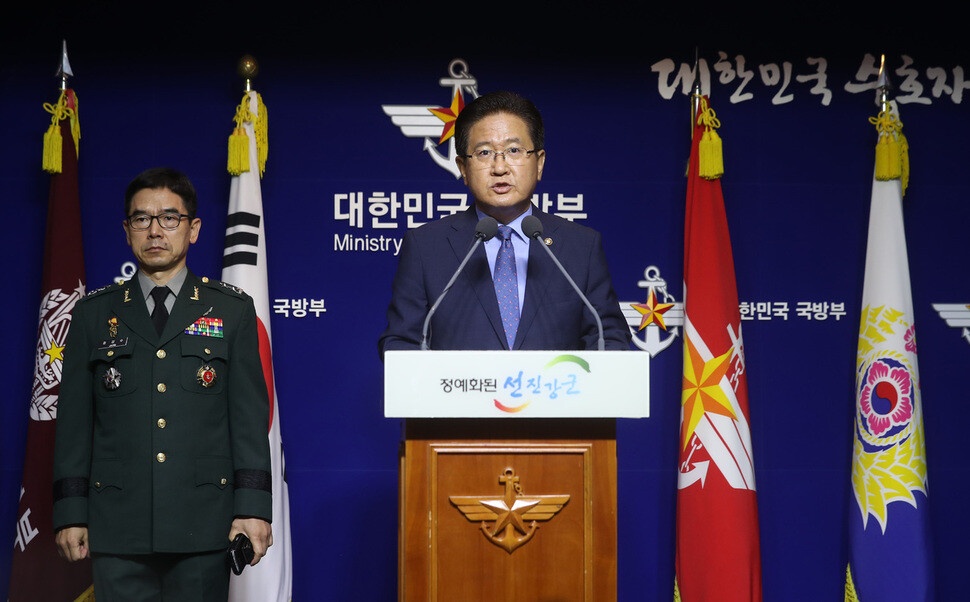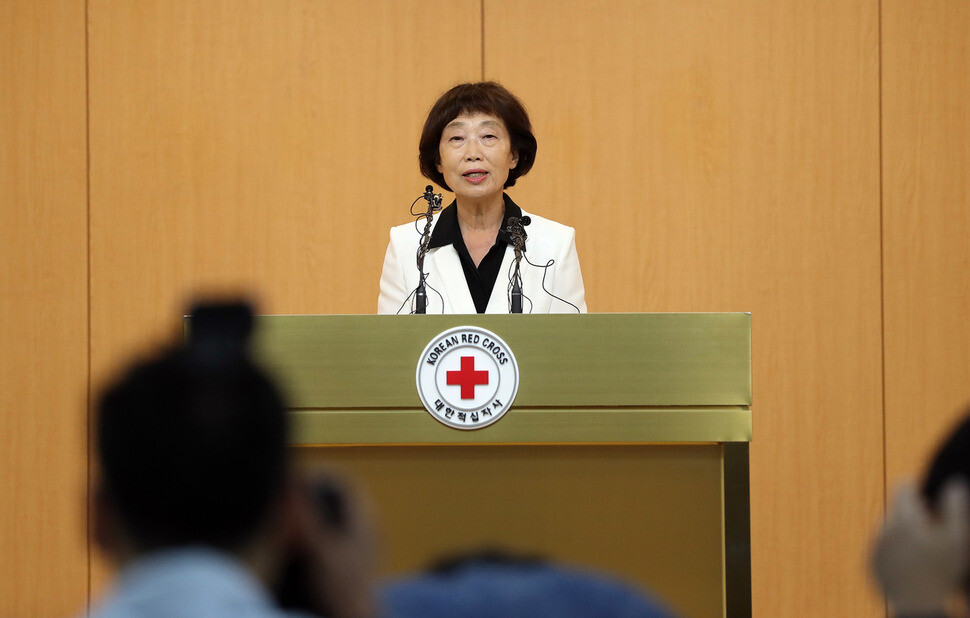hankyoreh
Links to other country sites 다른 나라 사이트 링크
[News analysis] Pres. Moon setting his N. Korea policy with proposal for talks

On July 17, the government of President Moon Jae-in proposed holding inter-Korean military talks to halt hostile activity on the military demarcation line, and Red Cross talks to organize a reunion of families divided by the Korean War. Significantly, Seoul proposed talks to Pyongyang without making any of the stipulations that Moon had previously made, such as waiting for the right conditions or insisting that North Korea halt its provocations and show its willingness to denuclearize. Coming 11 days after Moon unveiled his “Berlin Declaration” in Germany on July 6 as a blueprint for his North Korean policy, the proposals appear to reflect the government‘s resolve to simultaneously resolve the North Korean nuclear issue and restore inter-Korean relations in an attempt to relax tensions and bring peace to the Korean Peninsula.
The government also paid a great deal of attention to the format of the announcement of its proposal to North Korea. At 9 am on July 17, Vice Defense Minister Suh Choo-suk sent a statement (“A Proposal to Hold Inter-Korean Military Talks to Halt All Hostile Activity at the Military Demarcation Line”) to North Korea that proposed holding inter-Korean military talks at Tongilgak (the Unification Building), located on the North Korean side of Panmunjeom, on July 21. At the same time, Kim Seon-hyang, acting president of the Korean Red Cross, proposed holding Red Cross talks at the Peace House on the South Korean side of Panmunjeom on Aug. 1. The goal of the talks would be to organize reunions for divided families and visits to their ancestral graves on Oct. 4, which is not only Chuseok (the Korean harvest festival) but also the 10th anniversary of the Oct. 4 Summit Declaration.

Unification Minister Cho Myung-gyun held a press conference around 11 am and released a statement about follow-up measures to the Berlin Declaration. “Inter-Korean dialogue and cooperation aimed at bringing peace and easing tensions on the Korean Peninsula will give us a chance to help resolve the North Korean nuclear issue and to promote a virtuous cycle of mutual progress on inter-Korean relations and the North Korean nuclear issue,” Cho said in the statement. This means that the proposals announced by the Defense Ministry and by the highest-ranking official at the Red Cross, the people who would be directly in charge of these talks, were both officially recognized by the head of the Unification Ministry, which is in charge of inter-Korean relations. Cho once again emphasized the principle delineated by Moon in his Berlin Declaration that South Korea will not pursue a hostile policy toward the North, the collapse of the North Korean regime or unification by absorption. “We gave careful consideration to the format of the announcement to make it look as formal as possible to the North,” said an official in the Unification Ministry.
On several previous occasions, North Korea has asked for military talks to be held to relax inter-Korean tensions, while South Korea has pushed to hold reunions of the divided families on humanitarian grounds. The proposal to hold the military talks on the North Korean side of Panmunjeom and the Red Cross talks on the South Korean side of Panmunjeom essentially reflects this state of affairs. Simultaneously pursuing the military talks desired by the North and the Red Cross talks desired by the South represents an attempt to prime the pump on inter-Korean dialogue, which has been stalled for more than nine years. “Placing the military talks that North Korea has emphasized first is meant to emphasize to the North that relaxing tensions is the priority. Placing the Red Cross talks after the military talks appears to be aimed at increasing the possibility of bringing the talks off,” said Gu Gab-woo, a professor at the University of North Korean Studies.
Since operations were suspended at the Kaesong Industrial Complex in Feb. 2016, all lines of communication between North and South Korea have been cut. Since then, Seoul has had to use a megaphone at Panmunjeom to inform North Korea each time it returns North Korean fishermen who have drifted into South Korean waters in the East Sea, epitomizing the lack of communication between North and South Korea. By asking North Korea to use the military communication lines on the West (Yellow) Sea to respond to the proposal about military talks and to use the liaison office at Panmunjeom to respond to the proposal about Red Cross Talks, Seoul expressed its intention to seize this opportunity to restore the lines of communication between North and South Korea.
Moon had previously stated that there are preconditions for inter-Korean dialogue, such as North Korea stopping its provocations and showing its willingness to denuclearize (the Berlin Declaration) or waiting for the right conditions to be in place (the South Korea-US summit). The statement by Unification Minister Cho Myung-gyun also included the phrase “if North Korea chooses the right path.” But such preconditions were not attached to the proposals for military talks and Red Cross talks. “The necessity of the right conditions being in place is our basic position in regard to North Korea’s nuclear weapons and missile provocations. The fact that we nevertheless proposed [talks] should be understood as being an early attempt to bring peace and ease tensions between North and South Korea in order to resolve urgent issues, including the divided families,” Cho said.
“The phrases that have appeared about ‘right’ or ‘appropriate’ conditions represent a cautious approach given the growing seriousness of the North Korean nuclear issue,” said Korea National Strategy Institute director Kim Chang-soo. “If inter-Korean dialogue bears fruit beginning with the military talks and the Red Cross talks, that would mean those conditions are forming. What President Moon is saying is that if that kind of atmosphere forms, he will engage in dialogue that can improve inter-Korean relations in a much fuller and more fundamental way.”
With Moon unveiling his North Korean policy just over two months into his presidency, experts are calling for Moon to devise his own approach that is distinct from those adopted by former presidents Kim Dae-jung (1998-2003) and Roh Moo-hyun (2003-08). At the moment, even the most basic channels of inter-Korean dialogue are severed. North Korea‘s nuclear weapons and missiles have become more threatening, and the international community has bolstered its cooperation on sanctioning and pressuring the North. During the nine-year hiatus in inter-Korean dialogue, North Korea has also gotten a new leader. This suggests that it would be difficult to resolve the issue simply by using the existing framework for inter-Korean relations.
“Both North and South Korea are deeply distrustful of each other,” said Inje University professor Kim Yeon-cheol. “Early on in the talks, it’s obvious that [both sides] will stick to their guns and test the other side’s resolve. But trust is not the condition for dialogue but its outcome. Once dialogue begins, trust is built from scratch through the process of dialogue.”
“In the future, there will no doubt be crises, major differences and obstacles resulting from various circumstances. Nevertheless, we need to keep open at least the two channels of military talks and Red Cross talks and build inter-Korean relations slowly, instead of rushing,” Kim added.
By Jung In-hwan, staff reporter
Please direct questions or comments to [english@hani.co.kr]

Editorial・opinion
![[Column] Season 2 of special prosecutor probe may be coming to Korea soon [Column] Season 2 of special prosecutor probe may be coming to Korea soon](https://flexible.img.hani.co.kr/flexible/normal/500/300/imgdb/original/2024/0426/3317141030699447.jpg) [Column] Season 2 of special prosecutor probe may be coming to Korea soon
[Column] Season 2 of special prosecutor probe may be coming to Korea soon![[Column] Park Geun-hye déjà vu in Yoon Suk-yeol [Column] Park Geun-hye déjà vu in Yoon Suk-yeol](https://flexible.img.hani.co.kr/flexible/normal/500/300/imgdb/original/2024/0424/651713945113788.jpg) [Column] Park Geun-hye déjà vu in Yoon Suk-yeol
[Column] Park Geun-hye déjà vu in Yoon Suk-yeol- [Editorial] New weight of N. Korea’s nuclear threats makes dialogue all the more urgent
- [Guest essay] The real reason Korea’s new right wants to dub Rhee a founding father
- [Column] ‘Choson’: Is it time we start referring to N. Korea in its own terms?
- [Editorial] Japan’s rewriting of history with Korea has gone too far
- [Column] The president’s questionable capacity for dialogue
- [Column] Are chaebol firms just pizza pies for families to divvy up as they please?
- [Column] Has Korea, too, crossed the Rubicon on China?
- [Correspondent’s column] In Japan’s alliance with US, echoes of its past alliances with UK
Most viewed articles
- 1[Column] Season 2 of special prosecutor probe may be coming to Korea soon
- 2No good, very bad game for Korea puts it out of Olympics for first time since 1988
- 3‘We must say no’: Seoul defense chief on Korean, USFK involvement in hypothetical Taiwan crisis
- 4Division commander ordered troops to enter raging flood waters before Marine died, survivor says
- 5Is Japan about to snatch control of Line messenger from Korea’s Naver?
- 6Korea’s 1.3% growth in Q1 signals ‘textbook’ return to growth, says government
- 7Is N. Korea threatening to test nukes in response to possible new US-led sanctions body?
- 8[Editorial] Korea’s surprise Q1 growth requires objective assessment, not blind fanfare
- 9[Editorial] New weight of N. Korea’s nuclear threats makes dialogue all the more urgent
- 10[Editorial] In the year since the Sewol, our national community has drowned